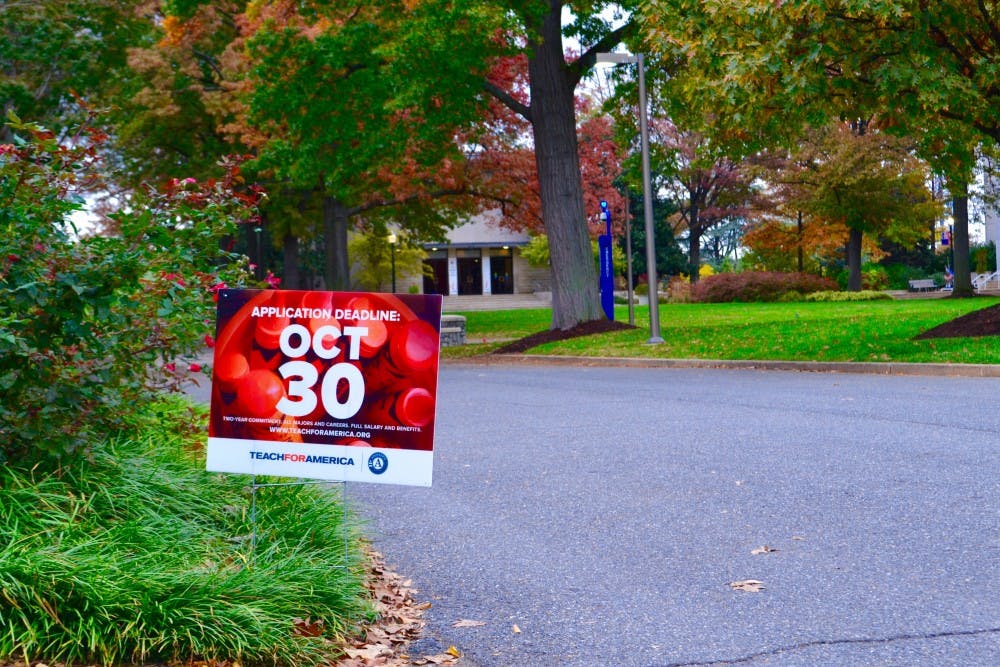2015 School of International Service alumna Nicole Piedra initially planned on working or researching abroad with her degree in international relations after she graduated. Instead, at the beginning of her senior year, she committed to two years of teaching in a charter school with Teach for America.
Immediately after graduation, Piedra entered a full-time intensive program that included teaching summer school, receiving feedback from a coach and learning how to create classroom lesson plans.
Piedra is one of 28 graduates from AU’s class of 2015 to join Teach for America. As a member of the 2015 Teaching Corps, she is currently in her first year as a middle school Spanish teacher at Vailsburg Middle School in Newark, New Jersey.
“Whenever you tell a student they did well on something, every student, no matter how tough they think they are, gets this little smile in the corner of their mouth, and they can't hide it,” Piedra said. “It's those little moments with a kid blowing you away that make it all worth it.”
In 2015, AU ranked second nationally for medium-sized schools for the amount of graduates the University sent to high-need classrooms with Teach for America. According to its website, TFA recruits recent college graduates of diversified areas of study to “strengthen the movement for educational equity and excellence.”
AU’s School of Education, like most other university teacher-training programs, offers a traditional route to teacher certification that includes four years of coursework and student teaching hours.
TFA recruits pursue an alternative route to becoming certified teachers, however. Most earn undergraduate degrees in areas other than education and join the program with limited previous related coursework. They undergo a summer of training before entering into a two-year commitment as TFA corps members in high-need schools across the country. Training continues throughout the first year in the corps.
“Most of the TFA corps members from AU are not education majors,” Julie Sara Boyd, the director of the office of teacher education said. “Our majors graduate with teacher certifications. TFA tends to attract people who want their certification and didn't get it in undergrad. When our majors graduate, they're already ready, and they've already been trained to be teachers. Typically those don't go on to do alternative certification."
Miriam Kerler, a 2015 AU graduate, is one of those corps members. As the daughter of educators, Kerler always had an interest in education. She majored in journalism and law studies and is currently a TFA Corps member serving as a second grade teacher at Marshall Elementary School in Tulsa, Oklahoma.
In her school district, Kerler said there is a shortage of approximately 200 teachers because Oklahoma offers one of the lowest salaries for teachers in the country. Although she feels supported by her school’s surrounding community in Oklahoma, she said many communities aren’t as receptive to TFA staff.
“When I talk to my friends about it, and they continue to have pushback, despite what I tell them about my kids, it’s kind of like how much do you really value the student if you have so much pushback on an organization?” Kerler, who said many of her friends in AU’s education program did not support TFA, said. “It doesn’t make sense to me. If you refuse to teach there, what other solution do you have?”
One such TFA critic, Julia D’Ambrosi, views TFA negatively based on her research on the impact of the program. D’Ambrosi is a first-year master’s student at AU pursuing a master’s of arts in K-12 art education. She holds a degree in communication arts-theater from Austin College and has been teaching at camps and other similar children's theater programs for three years. She plans to teach visual art at a traditional public school in D.C. upon graduation.
“I think it’s unethical,” D’Ambrosi said of TFA. “It's unacceptable that we are sending people with only five weeks of experience to teach low-income Hispanic and black students when we would never do that for affluent white students.”
D’Ambrosi said she prefers alternatives to TFA such as City Year and Teach Grants. Both programs aim to reduce education inequality in low-income areas in different ways. City Year strives to bridge obstacles that impede education by enlisting recent college graduates for support in at-risk schools, rather than serving as head teachers. Teach Grants financially supports education majors planning to teach at low-income schools or in a high-need field.
As a graduate of the education school and a certified teacher, Sydney Bell, a second-year TFA corps member and second grade teacher in Oklahoma City, does not represent the majority of her fellow corps members who commit to TFA without education degrees. Bell applied for TFA because she knew that she wanted to teach at a low-income school but wasn’t sure where she wanted to teach.
“Because of the state of education in our country, we need TFA,” Bell said. “But at the same time, I think it is really hard because teachers only have a summer of training because they don’t yet have a set of skills to teach. At first it is really hard to develop that skill set.”
D’Ambrosi said developing as a teacher takes time beyond TFA’s typical two-year placement. She cited a study from the Great Lakes Center for Education Research & Practice, a regional think-tank. The study found that teacher effectiveness “dramatically rises after the first few years,” which contradicts data published by TFA that supports the TFA model of two-year commitments. D’Ambrosi also said she disagrees with TFA’s emphasis on using teaching as “a stepping stone to other areas.”
“The mission of TFA is not to create long-term teachers,” D’Ambrosi said. “I think that's fundamentally wrong. Children should not be used as guinea pigs and the point of teaching a class is to help the kids as much as possible, not to use it as a stepping stone for something else.”





